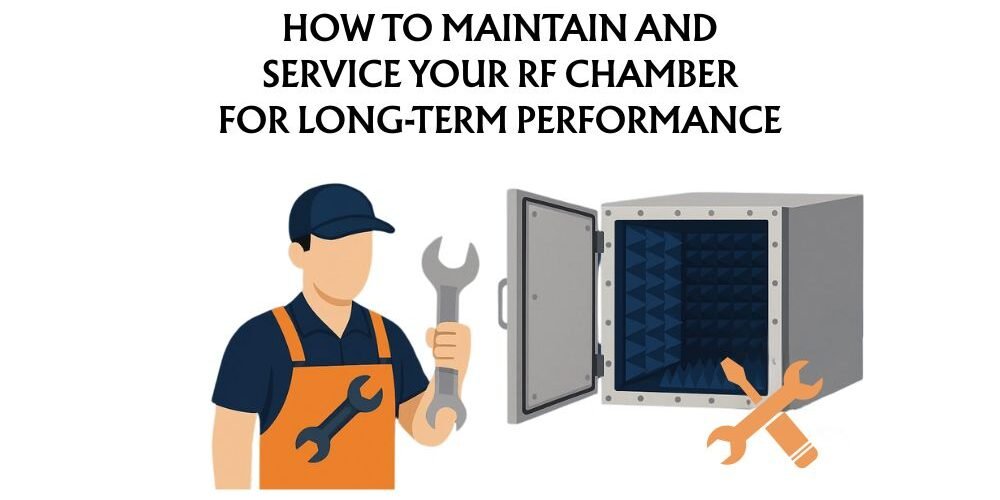RF Chambers (Radio Frequency) chambers are critical assets for testing and validation across defence, aerospace, automotive, telecommunications, and electronics industries. These chambers are engineered for precision, longevity, and consistent performance. However, like any specialised infrastructure, they require structured maintenance and service protocols to retain their calibration, shielding effectiveness, and overall operational integrity.
In this blog, we will explore the importance of maintenance, outline routine and preventive maintenance activities, and share best practices to maximise your chamber’s life span and performance.
Why RF Chamber Maintenance is Critical
- Ensures Accurate Testing Results
An unmaintained chamber can develop minor leaks or absorber degradation, leading to incorrect test results, failed compliance checks, and costly retesting. - Protects High-Cost Assets
Your RF chamberrepresents a substantial capital investment. Regular servicing ensures long-term asset protection, reducing the risk of sudden major repairs. - Maintains Safety Standards
Loose panels, degraded absorbers, or exposed conductive materials can pose safety hazards to operators and equipment inside the chamber. - Avoids Downtime
Scheduled maintenance prevents unexpected breakdowns, ensuring maximum uptime for your testing operations.
Routine Maintenance Checklist
Below are practical steps for routine RF chamber maintenance:
- Visual Inspection
Conduct a weekly or bi-weekly visual inspection to identify:
- Absorber wear or damage: Check for tears, burns, or dust accumulation on RF absorbers(pyramidal foam, ferrite tiles, or hybrid). Damaged absorbers can affect chamber reflectivity and field uniformity.
- Panel seams and joints: Inspect RF shielded panels for gaps, corrosion, or loose screws that might compromise shielding integrity.
- Doors and seals: The door is the most used and vulnerable part of the chamber. Check RF finger stock, gaskets, and hinges for wear or damage. Replace if necessary to maintain shielding effectiveness.
- Cleanliness Maintenance
- Dust control: Use a soft brush or industrial vacuum with non-metallic attachments to clean absorbers without damaging them. Avoid wet cleaning unless recommended by the absorber manufacturer.
- Floor cleaning: Clean chamber floors using approved methods. Ensure that cleaning agents do not produce vapours that can degrade absorbers or leave conductive residues.
- Electrical and Mechanical Checks
- Power connections: Inspect lighting fixtures, control panels, and power outlets inside the chamber for loose connections or exposed wiring.
- HVAC systems: Check ventilation filters and airflow units to ensure proper chamber cooling and environmental control.
Preventive Maintenance Activities
In addition to routine maintenance, preventive maintenance should be scheduled quarterly or biannually, depending on usage intensity.
- Shielding Effectiveness Test
Conduct a shielding effectiveness test to verify that the chamber continues to block external RF interference adequately. Any reduction in shielding effectiveness indicates possible leaks, seal failure, or panel degradation.
- VSWR and Return Loss Checks
Check the Voltage Standing Wave Ratio (VSWR) and return loss performance of antenna and wireless device testing chambers to ensure that absorbers and chamber reflections remain within design tolerances.
- Absorber Performance Testing
Absorbers can degrade due to age, UV exposure, or high-power testing. Periodic reflection loss measurements can determine if absorber replacement is needed to maintain the chamber’s anechoic properties.
- Door and Latch Servicing
- Lubricate mechanical parts using manufacturer-approved lubricants to avoid corrosion.
- Replace RF gaskets or finger stock showing wear to maintain proper contact and shielding performance.
Professional Servicing and Calibration
While in-house maintenance is essential, engaging professional RF chamber servicing specialists annually or as recommended ensures:
- Calibration of instrumentation and chamber field probes.
- Shielding integrity surveys using advanced scanning equipment.
- Detailed inspection reports with actionable recommendations.
- Compliance with ISO, MIL-STD, CISPR, and other applicable standards.
Best Practices for Long-Term Performance
- Maintain Manufacturer Records and Guidelines
To avoid warranty issues, always follow the maintenance schedule outlined by the chamber manufacturer or integrator. - Train Operators and Maintenance Teams
Ensure staff are trained in correct cleaning methods, visual inspection protocols, and operational limitations to avoid damage. - Limit Unnecessary Access
Restrict access to authorised personnel to reduce accidental damage to absorbers, walls, and sensitive components. - Environment Control
Maintain temperature and humidity levels within the recommended range to prevent absorber degradation and material warping. - Upgrade and Retrofit When Required
As technology evolves, consult with your chamber supplier about absorber upgrades or RF system retrofits to extend the operational relevance and performance of your system.
RF chambers are mission-critical assets that require dedicated care for optimal, reliable, and safe performance. Implementing a structured maintenance and servicing schedule not only protects your investment but also ensures precise, repeatable test results necessary for product development, compliance, and operational excellence.
If you require professional RF chamber maintenance services, shielding effectiveness testing, or absorber replacement recommendations, please contact our experienced team today to ensure your chamber continues to perform at its peak for decades to come.

